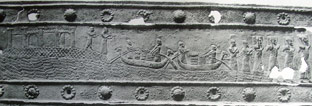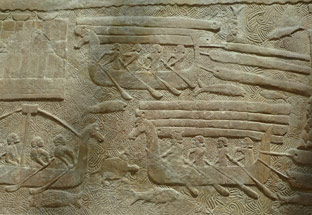Tyre and the other Phoenician city-states
Assyria had a long tradition of maintaining economic contacts with the Phoenician city-states but its westward expansion resulted in increasingly closer relations: while Tyre in particular benefited from Assyria's protection and preferential treatment, the representatives of the Assyrian Empire did not hesitate to intervene directly in its affairs when they saw fit.

Cultural continuity on the Lebanese coast
The great migrations of the 12th century BC changed the population profile of the Middle East, and new groups of peoples such as the Aramaeans, the Philistines and the Phrygians appear in the historical record. Yet we can observe a remarkable continuity in the area of what is today the Lebanese coast. This narrow strip of land between the sea and the impressive Lebanon mountain range accommodated some of the most important harbours of the eastern Mediterranean, namely Sidon, Byblos and the two island cities of Tyre and Arwad (off the Syrian coast near Tartus), where the Canaanite culture of the Bronze Age continued to flourish.
As in the second millennium BC, all these cities were active in maritime trade. They were politically independent, each with its own government headed by a king. They all pursued their own political and especially economic interests but they shared a language and a culture: the Greeks certainly saw them as one people and called them the Phoenicians (Greek Phoinix, pl. Phoinikes).
The colour purple and the cedars of Lebanon

While the term Phoinix may ultimately be a loanword derived from Egyptian, it was seen as intimately linked to the identical Greek word used for both the murex snail and the colour purple, extracted from that creature's glandular mucus. The manufacture of purple dye was a closely guarded Phoenician trade secret, and textiles dyed with it belonged to the most sought-after luxuries among the many precious goods in which the Phoenician merchants traded. The Assyrian court, where purple garments served as a sign of royal recognition, was one of their most important clients.
Murex snails were not the only resource that made the Lebanese coast an excellent environment for industry and trade. In antiquity, the Lebanon range was still covered by extensive cedar forests of which only small remnants survive today. Growing up to 40 metres tall and with a very straight trunk, the timber of these cedars was in great demand all over the Middle East as building material: the grandest halls of the Assyrian palaces and temples could only be built by using cedars as roof beams.
On the Lebanese coast itself, the timber was used to build the seagoing ships which the Phoenicians used to traverse the Mediterranean Sea and, at least from the 6th century BC onwards, also to sail the Atlantic and Indian Oceans (the latter via the Red Sea).
Collaborating with Assyria, colonising the Mediterranean

From the 9th century BC, the Phoenician city-states founded permanent settlements beyond the Lebanese coast. The first of these was at Kition on the island of Cyprus where Tyre established a formal colony in order to control the export of the rich Cypriote copper deposits and to cut off their Phoenician competitors who, like Tyre, had pursued their commercial interests on Cyprus for at least the previous two centuries. The Tyrian settlement was surrounded by a network of small city-states under the rule of local kings, whom the king of Tyre considered his vassals. Foundations in northern Africa (most famously Carthage, "the New City"), Sicily, Sardinia and Spain followed.
Tyre can certainly be seen as the motor of the westward expansion, and this close ally of Assyria benefited from the treaties between the two states which guaranteed Tyre privileged access to all harbours under Assyrian control and gave it an invaluable advantage over its competitors, including the other Phoenician states. One of these treaties survives in the original, albeit in a very fragmentary state (SAA 2 5 [http://oracc.museum.upenn.edu/saao/saa02/P336126/html]), and from this document drawn up between Esarhaddon of Assyria (681-669 BC) and Ba'alu of Tyre we learn that this privilege came at the price of admitting the Assyrian ambassador (qēpu) to all Tyrian bodies of political decision-making.

Such an arrangement was already in place during the reign of Tiglath-pileser III (744-727 BC), as shown by some letters from the king's correspondence with the governor of Ṣimirra, the Assyrian province bordering on the territory of Tyre (NL 13 = SAA 19 23, NL 21 = SAA 19 24). Another letter (NL 12 = SAA 19 22) highlights that the Assyrians monitored and taxed Tyre's and Sidon's trade and controlled access to the Lebanon wood supplies, outlawing any timber deliveries to the Philistines and the Egyptians: while Assyria's relations with these regions were not yet openly hostile, neither had they formally accepted Assyrian sovereignty at that time, and this course of action was designed to make them suffer the consequences.
In exchange for accepting Assyrian interference, Tyre and the other allied Phoenician city-states were in a position to ask their overlord to support them against their enemies. Hence, Sargon II (721-705 BC) provided troops to Tyre in 715 BC in order to fend off Ionian pirates who were threatening its maritime network, and again in 709 or 708 BC in order to regain control over its local vassal rulers on Cyprus. These troops were shipped aboard the Tyrian fleet, as Assyria did not maintain a navy of its own. But these first experiences of naval warfare clearly left a lasting impression and the use of Phoenician ships in the wars in the marshes of southern Babylonia during the reign of Sennacherib (704-681 BC) can be seen as their direct result.
The Phoenician alphabet
Their trade networks made the Phoenicians rich but also enabled cultural exchange and transfer between East and West in an unprecedented way: the most significant was the spread of the alphabetic script which was adopted all over the Mediterranean.

The Phoenician alphabet is a writing system consisting of only 22 signs representing exactly one sound (phoneme) each. The term "alphabet" derives from the names of the first two signs in the sequence, aleph ("cattle") and beit ("house"): these names also reflect the letters' shapes, each derived from the picture of an object whose name starts with the relevant sound.
The alphabetic script is simple enough to learn quickly, without the years of dedicated training required to master writing systems such as cuneiform or Egyptian hieroglyphs. Specialised schooling was unnecessary, and literacy was therefore disengaged from the institutional context of palaces and temples where the traditional scripts continued to be used. The alphabet suited the needs of long-distance merchants who needed to be able to record their business affairs on the go and who, for reasons of confidentiality and money, often preferred to write themselves rather than employ a specialist scribe. As the script could easily be used to record any language, it was, in the course of the first millennium BC, adapted for Aramaic, Hebrew, Greek, Phrygian, Lydian, Etruscan and Latin, to name but a few.
Further reading:
Na'aman, 'Tiglath-pileser III's campaigns against Tyre and Israel', 1995.
Na'aman, 'Sargon II and the rebellion of the Cypriote kings against Shilta of Tyre', 1998.
Radner, 'Assyrische Handelspolitik', 2004.
Yamada, 'Qurdi-Assur-lamur: his letters and career', 2008.
Content last modified: 5 Nov 2012.
Karen Radner
Karen Radner, 'Tyre and the other Phoenician city-states', Assyrian empire builders, University College London, 2012 [http://www.ucl.ac.uk/sargon/essentials/countries/phoenicians/]